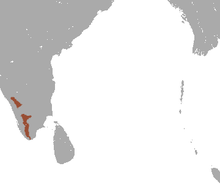Nilgiri langur: Difference between revisions
No edit summary Tags: Visual edit Mobile edit Mobile web edit |
BhagyaMani (talk | contribs) →top: rem refs out of lead |
||
| Line 23: | Line 23: | ||
}} |
}} |
||
The '''Nilgiri langur''' ('''''Semnopithecus johnii''''') |
The '''Nilgiri langur''' ('''''Semnopithecus johnii''''') is an Asian [[langur]] of the [[Old World monkey]]. It has glossy, black fur and an orangey-golden brown, hair-like mane on its head. Females have a white patch of fur on the inner thigh. It typically lives in troops of nine to ten individuals, with or without offspring, depending on seasonality. Its diet consists of fruits, shoots and leaves. It is listed as [[Vulnerable species|Vulnerable]] on the [[IUCN Red List]] and is threatened by [[habitat destruction]] and [[poaching]] for its body parts thought to have [[aphrodisiac]] properties. |
||
==Taxonomy and classification== |
==Taxonomy and classification== |
||
Revision as of 06:22, 28 April 2024
| Nilgiri langur | |
|---|---|

| |
| Nilgiri langur eating fruit. | |

| |
| At Parambikulam. | |
| Scientific classification | |
| Domain: | Eukaryota |
| Kingdom: | Animalia |
| Phylum: | Chordata |
| Class: | Mammalia |
| Order: | Primates |
| Suborder: | Haplorhini |
| Infraorder: | Simiiformes |
| Family: | Cercopithecidae |
| Genus: | Semnopithecus |
| Species: | S. johnii
|
| Binomial name | |
| Semnopithecus johnii (J. Fischer, 1829)
| |

| |
| Nilgiri langur range | |
| Synonyms[2] | |
| |
The Nilgiri langur (Semnopithecus johnii) is an Asian langur of the Old World monkey. It has glossy, black fur and an orangey-golden brown, hair-like mane on its head. Females have a white patch of fur on the inner thigh. It typically lives in troops of nine to ten individuals, with or without offspring, depending on seasonality. Its diet consists of fruits, shoots and leaves. It is listed as Vulnerable on the IUCN Red List and is threatened by habitat destruction and poaching for its body parts thought to have aphrodisiac properties.
Taxonomy and classification
The classification of the Nilgiri langur has been disputed. Traditionally it has been placed within the genus Trachypithecus based on morphological similarities such as cranial morphology and neonatal pelage color, and within the Trachypithecus vetulus group within Trachypithecus based on a presumed close relationship with the purple-faced langur, which had been classified as Trachypithecus vetulus. DNA and other evidence suggests that the Nilgiri langur and purple-faced langur are more closely related to the gray langurs and have thus been reclassified within the genus Semnopithecus.[3][4][5][6][7][8]
Distribution
The Nilgiri langur is found in its namesake Nilgiri Hills, within the Western Ghats, of South India. Its range also includes Kodagu (Karnataka), Kodayar Hills (Tamil Nadu), and other hilly areas in Kerala and Tamil Nadu. It is also found in Silent Valley National Park, Kerala.[9]
Description
The head-plus-body length is 78–80 cm in adult males and 58–60 cm in adult females, with the tail adding between 68.5 and 96.5 cm. The males weigh 9.1-14.8 kg, the females 10.9–12 kg.[10] The gestation period is not precisely known but assumed to be similar to the closely related Hanuman Langur, i.e. 200 days.[10]
References
- ^ Singh, M.; Kumara, H.N.; Kumar, A. (2020). "Semnopithecus johnii". IUCN Red List of Threatened Species. 2020: e.T44694A17958623. doi:10.2305/IUCN.UK.2020-2.RLTS.T44694A17958623.en. Retrieved 19 November 2021.
- ^ Groves, C. P. (2005). Wilson, D. E.; Reeder, D. M. (eds.). Mammal Species of the World: A Taxonomic and Geographic Reference (3rd ed.). Baltimore: Johns Hopkins University Press. p. 178. ISBN 0-801-88221-4. OCLC 62265494.
- ^ Wilson, Don E.; Mittermeier, Russell A.; Rylands, Anthony B. (2012). "Introduction". Handbook of the Mammals of the World, Volume 3: Primates (1st ed.). Lynx Edicions. ISBN 978-8496553897. Retrieved 30 August 2018.
- ^ Osterholz, Martin; Walter, Lutz; Roos, Christian (2008). "Phylogenetic position of the langur genera Semnopithecus and Trachypithecus among Asian colobines, and genus affiliations of their species groups". BMC Evolutionary Biology. 8 (58): 58. Bibcode:2008BMCEE...8...58O. doi:10.1186/1471-2148-8-58. PMC 2268674. PMID 18298809.
- ^ Brandon–Jones, D.; et al. (2004). "Asian Primate Classification". International Journal of Primatology. 25 (1): 97–164. CiteSeerX 10.1.1.694.7983. doi:10.1023/B:IJOP.0000014647.18720.32. S2CID 29045930.
- ^ Xiao Ping Wang; et al. (27 April 2012). "Phylogenetic Relationships among the Colobine Monkeys Revisited: New Insights from Analyses of Complete mt Genomes and 44 Nuclear Non-Coding Markers". PLOS ONE. 7 (4): e36274. Bibcode:2012PLoSO...736274W. doi:10.1371/journal.pone.0036274. PMC 3338693. PMID 22558416.
- ^ "Semnopithecus johnii". ITIS Report. ITIS. Retrieved 18 January 2020.
- ^ Karanth, K. Praveen; et al. (2008). "Molecular phylogeny and biogeography of langurs and leaf monkeys of South Asia (Primates: Colobinae)" (PDF). Molecular Phylogenetics and Evolution. 46 (2): 683–694. doi:10.1016/j.ympev.2007.11.026. PMID 18191589. Retrieved 30 August 2018.
- ^ Govt of India (27 October 2020). The Gazette of India (PDF). Govt. of India. p. 20. Retrieved 14 April 2022.
- ^ a b Cite error: The named reference
studybkwas invoked but never defined (see the help page).

